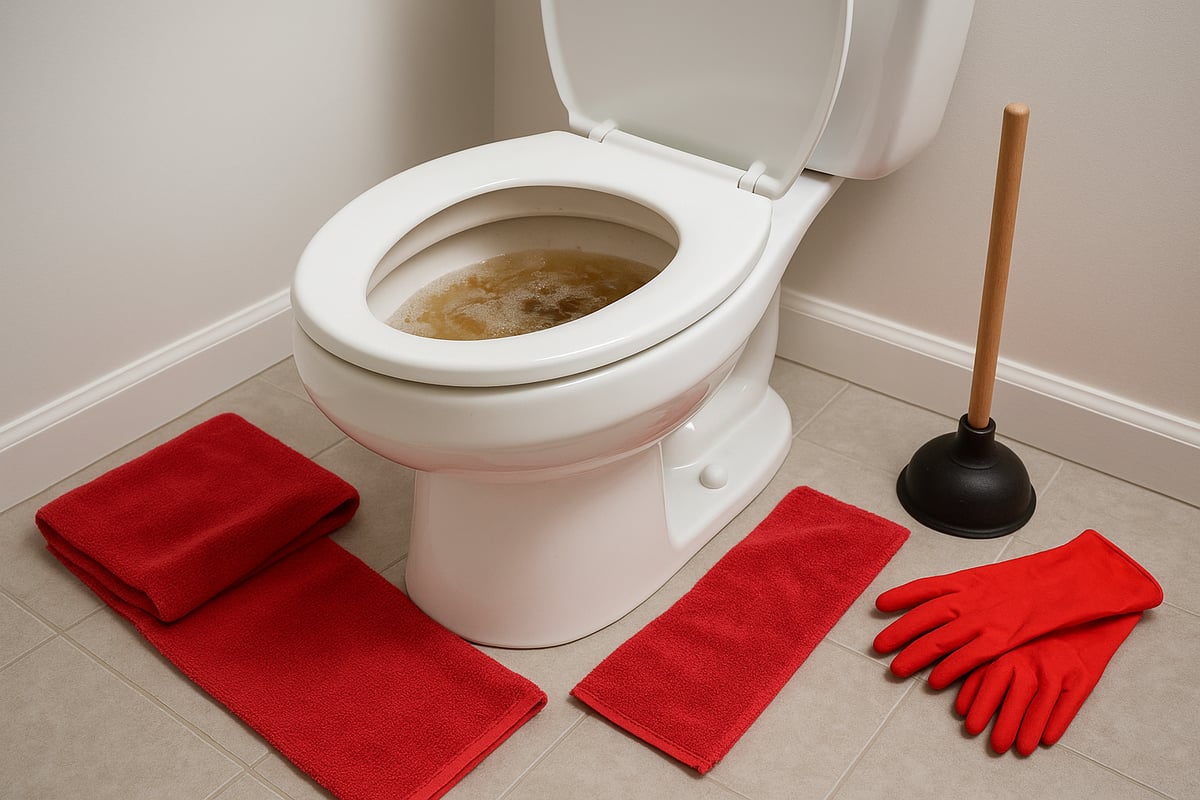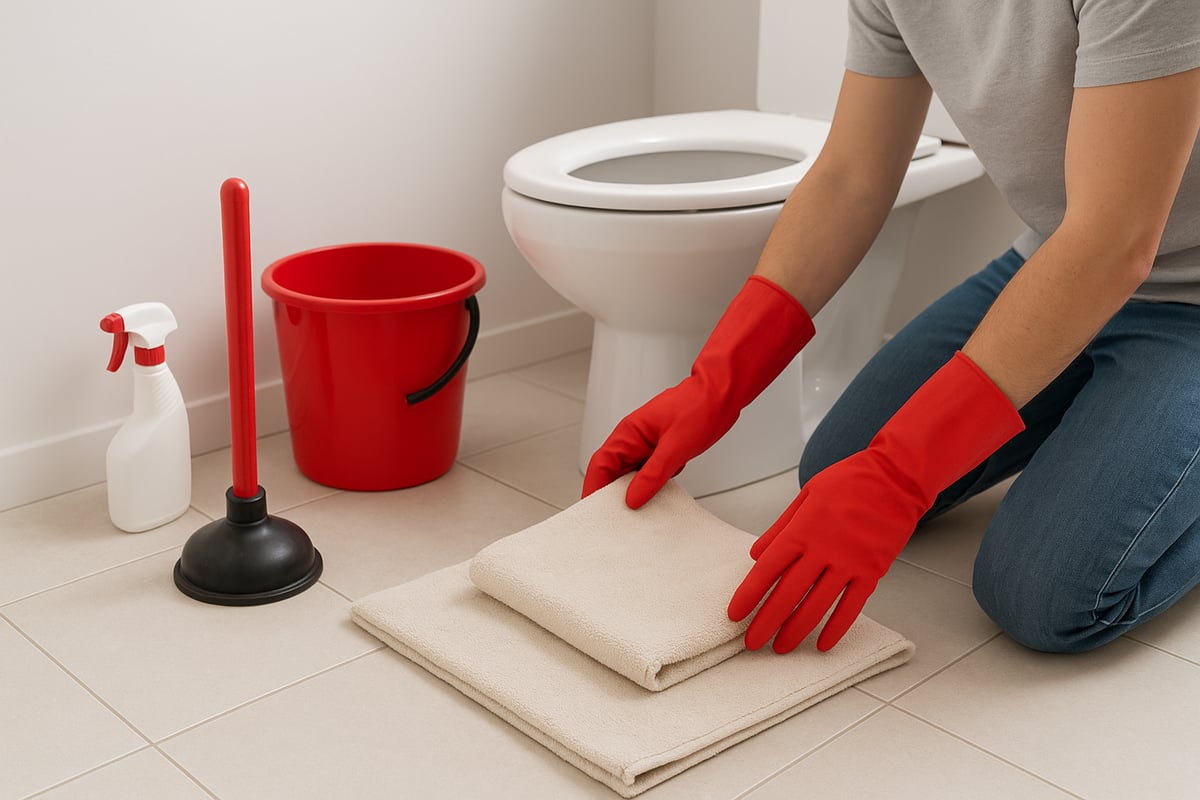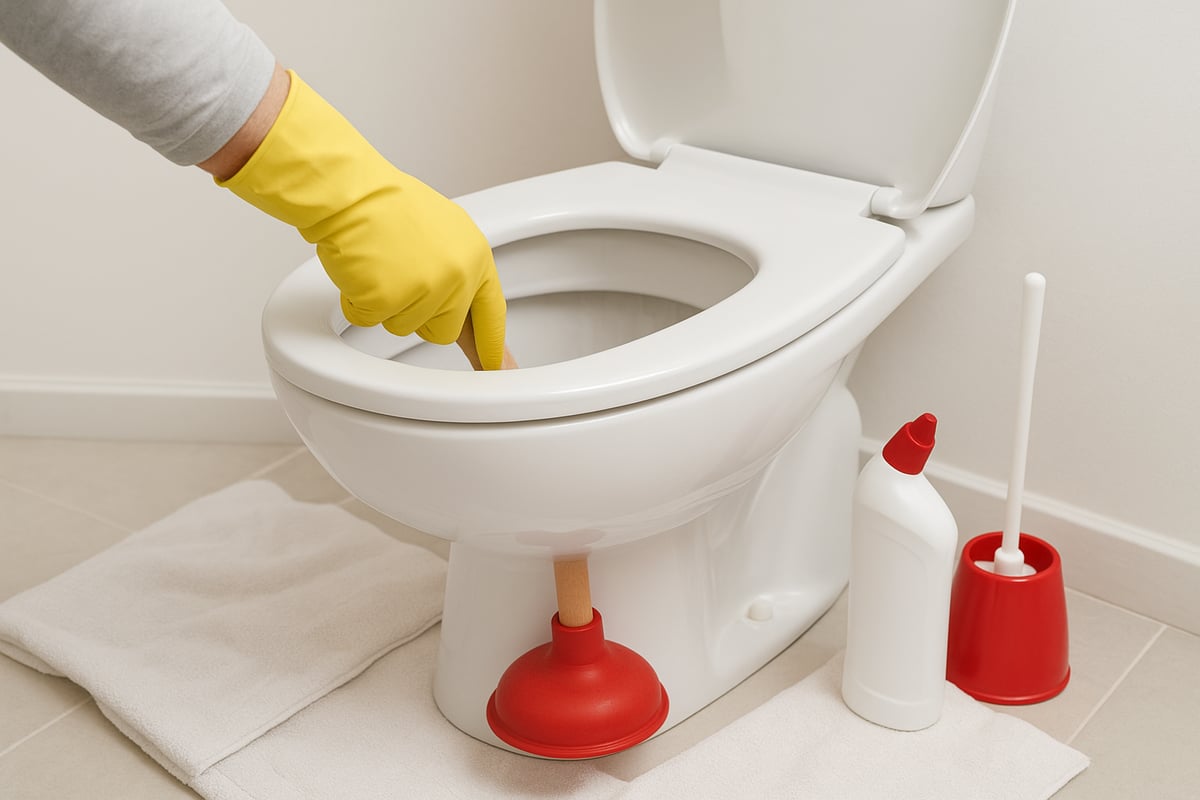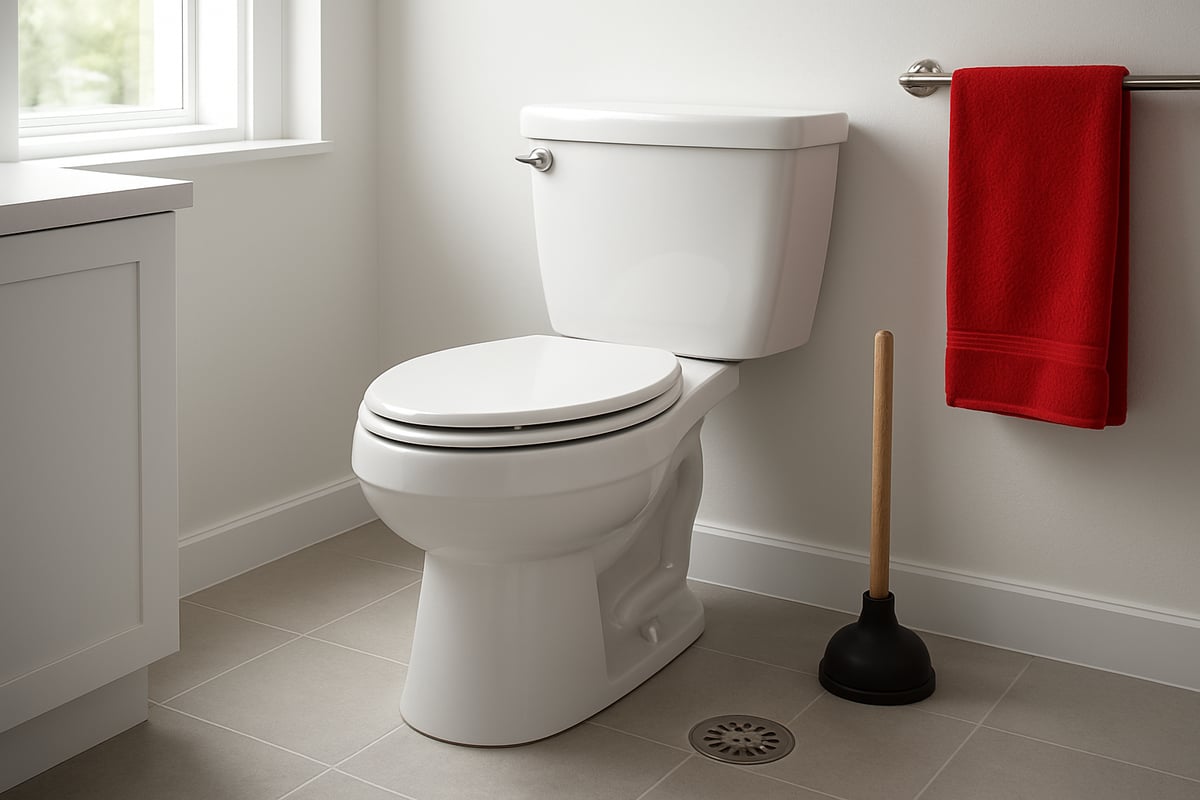Toilet Clogged Guide: Expert Solutions for a Stress-Free Fix 2025
A toilet clogged situation can quickly turn your peaceful morning into a stressful ordeal. Luckily, you do not have to panic or call for help straight away.
This guide is here to give you expert, step-by-step solutions for unclogging toilets in 2025. Whether you are a homeowner or a renter, you will find actionable methods, prevention tips, and professional insights to tackle any blockage with confidence.
You will discover what causes blockages, how to fix them yourself, ways to prevent future issues, and when it is time to bring in a professional. Read on for clear answers and practical steps to make your next fix stress-free.
Understanding Toilet Clogs: Causes and Signs
A toilet clogged situation can catch anyone off guard, yet the causes and warning signs are often right in front of us. Understanding what leads to a blocked toilet and how to spot issues early is the first step to a stress-free fix.

Common Causes of Toilet Clogs
Several everyday habits can result in a toilet clogged far more quickly than you might expect. The most frequent culprit is flushing non-flushable items such as wipes, sanitary products, and cotton balls. Even though packaging might claim “flushable,” these items rarely break down and often create stubborn blockages.
Excessive use of toilet paper is another common reason. Large wads can clump together and restrict water flow, especially in older plumbing systems. Hard water build-up and mineral deposits can gradually narrow pipes, making it easier for waste to get trapped. Pouring grease or oil into the toilet may seem harmless, but these substances solidify and cling to pipe walls, leading to gradual blockages.
Tree roots can invade underground sewer lines, especially in older properties, causing recurring toilet clogged problems that DIY methods can’t resolve. Even organic waste, though less frequent, can sometimes accumulate if the flush is weak or the pipes are already narrowed.
According to a national survey on common plumbing issues, wipes and sanitary items are responsible for a significant percentage of home toilet clogged incidents. The table below summarises top causes:
| Common Cause | Likelihood | Notes |
|---|---|---|
| Non-flushable items | High | Wipes, sanitary products |
| Excess toilet paper | High | Often in family households |
| Hard water build-up | Medium | Gradual, unnoticed |
| Grease/oil disposal | Medium | Solidifies in cold pipes |
| Tree root intrusion | Low | Older properties |
Being mindful of what goes down the toilet is the best defence against a toilet clogged headache.
Recognising the Signs of a Clogged Toilet
Spotting the early signs of a toilet clogged issue makes a world of difference. One of the first red flags is water rising higher than usual or failing to drain after a flush. This often signals a partial blockage that needs attention before it worsens.
Listen for unusual gurgling or bubbling sounds, either from the toilet or nearby pipes. These noises suggest trapped air escaping as water struggles past a clog. A weak or incomplete flush is another sign, especially if it happens repeatedly.
Persistent foul odours coming from the bowl can indicate waste or paper stuck in the pipes. If you notice water pooling around the base of the toilet, this could mean the water is searching for another escape route, which raises the risk of a messy overflow.
Recurring blockages are a clear warning that the underlying problem is not being resolved. Data shows that up to 80% of toilet clogged cases show early warning signs before a full blockage occurs. By acting quickly, you can avoid a full-blown plumbing emergency.
If you notice several of these signs together, it’s best to take action right away and prevent further complications.
Essential Preparation: What to Do Before You Start
Dealing with a toilet clogged issue can be stressful, but the right preparation makes all the difference. Before you tackle any blockage, taking a few essential steps will help you work safely, minimise mess, and set yourself up for success.

Safety and Mess Prevention Steps
When faced with a toilet clogged situation, your first priority should be safety and cleanliness. The moment you notice the water rising, stop flushing immediately. This simple move can save you from an overflowing mess and extra hassle.
Next, lay down old towels or newspapers around the toilet base. This step protects your floor from accidental spills or splashes. Always wear sturdy rubber gloves, as direct contact with waste water can expose you to harmful germs.
Proper ventilation is key, so open a window or switch on the extractor fan to keep the air fresh. Gather your essential tools before you start: a reliable plunger, a bucket, and suitable cleaning supplies. If you've already tried a chemical cleaner, never plunge straight after, as this can cause dangerous splashes.
Taking these steps means you're ready to handle a toilet clogged problem with confidence and less mess.
Assessing the Severity of the Clog
Once you've set up your safety zone, it's time to figure out just how bad the toilet clogged issue really is. Start by checking the water level and what's visible in the bowl. Is the water draining slowly, or is it not moving at all? This helps you judge the seriousness of the blockage.
Next, find out if the problem is local to your toilet or affecting other drains in your home. If your sinks or shower are also backing up, you might have a bigger issue. In these cases, turn off the water supply to the toilet to prevent overflow.
Look for warning signs that suggest a deeper plumbing problem, like gurgling sounds from other pipes or water pooling around the base. If you spot these, it could mean a mainline blockage that needs professional help. According to plumbers, 65% of single-toilet clogged cases are minor and can be fixed with DIY steps.
If you're ever unsure, or if the blockage keeps coming back, check out general plumbing advice for more tips and guidance. These checks help you decide the best way forward and avoid making the situation worse.
Step-by-Step Solutions: How to Unclog Your Toilet
A toilet clogged at the worst possible moment can quickly turn stressful. The good news? You can tackle most blockages yourself with the right approach. Below, you will find five proven methods, each designed to help you clear a toilet clogged in various scenarios. Let’s walk through each technique, their benefits, and when to escalate to professional support.

Method 1: Washing-Up Liquid & Hot Water Technique
This gentle approach is ideal when you first notice your toilet clogged and want to avoid harsh chemicals.
Steps:
- Pour a generous amount of washing-up liquid into the bowl. The soap acts as a lubricant, helping to break down the blockage.
- Let the liquid sit for 10–15 minutes. This gives it time to coat and loosen anything causing your toilet clogged.
- Carefully add a bucket of hot (not boiling) tap water from waist height. The water’s force helps push the blockage, while the heat softens it.
- Wait 20–30 minutes, allowing the mixture to work its magic on the toilet clogged.
- Test flush. If the water drains as normal, you have succeeded. If not, repeat the process once.
Many users find this method effective for minor blockages, especially when the toilet clogged is caused by too much paper. Caution: Never use boiling water, as it can crack porcelain. User comments often stress that hot tap water is sufficient and much safer for your toilet clogged.
Method 2: Plunging—The Classic Approach
If you notice your toilet clogged after the first flush, the plunger is your best friend.
Steps:
- Choose a bell-shaped or flange toilet plunger for the best seal. These are designed specifically for toilet clogged scenarios.
- Ensure the plunger is fully submerged and forms a tight seal over the drain hole.
- Start with gentle pushes to expel air. This prevents splashing and ensures effective pressure on your toilet clogged.
- Plunge vigorously up and down for 20–30 seconds.
- Break the seal with a sharp upward motion to maximise pressure.
- Check if the water drains. If the toilet clogged persists, repeat as needed.
Plunging resolves up to 90% of minor toilet clogged cases, making it a staple in every home. Always clean the plunger thoroughly after use to prevent bacteria build-up.
Method 3: Baking Soda & Vinegar Reaction
For those who prefer an eco-friendly approach, this method can dissolve organic matter causing a toilet clogged, without damaging pipes.
Steps:
- Pour one cup of baking soda directly into the toilet bowl. Allow it to settle for a few minutes.
- Slowly add two cups of white vinegar. The fizzing reaction helps break down the blockage causing your toilet clogged.
- Let the mixture work for at least 30 minutes. For tough toilet clogged cases, leave it for a few hours or overnight.
- Flush to test if the water drains freely.
This remedy is safe for all plumbing and septic systems. It’s especially useful for organic waste blockages and is a favourite among those wanting a chemical-free solution for a toilet clogged.
Method 4: Toilet Auger (Plumber’s Snake) for Stubborn Clogs
When your toilet clogged remains after trying the above, a toilet auger can reach deeper and dislodge solid blockages.
Steps:
- Use a toilet-specific auger to avoid scratching the porcelain.
- Insert the auger into the drain opening. Crank the handle to extend the cable into the toilet clogged area.
- Gently work the auger to break up or retrieve the clog. Do not force, as this may damage pipes.
- Retract the cable and remove any debris caught on the end.
- Flush to check if the blockage is gone. Repeat if needed.
This tool is especially effective for hard objects or deep-set blockages that leave the toilet clogged despite other efforts. Always clean the auger after use.
Method 5: Commercial Drain Cleaners (Last Resort)
If your toilet clogged persists after manual methods, a chemical drain cleaner is a last resort. Use these with caution.
Steps:
- Only select products labelled as safe for toilets. Many general drain cleaners can damage porcelain or pipes.
- Put on heavy-duty gloves and safety goggles, and ventilate the room well.
- Pour the recommended amount into the bowl, following the instructions carefully.
- Wait the specified time before flushing. Do not mix with other chemicals or plunge immediately after use, as this can cause dangerous splashes.
- Flush thoroughly after waiting.
Warning: Chemical cleaners can damage plumbing and harm the environment. Less than 10% of toilet clogged cases require chemical intervention, so use sparingly and only after other methods have failed.
When DIY Methods Don’t Work: What Next?
If your toilet clogged remains stubborn after several attempts, it may be time to call in a professional. Persistent blockages, water backing up in other drains, or repeated issues suggest a deeper problem in your plumbing.
Avoid forcing the issue, as this can cause overflow or pipe damage. Mainline blockages or tree root invasions require special tools and expertise. In these cases, consider reaching out to Drainage and plumbing services for expert help. Professionals use CCTV inspections and power augers to diagnose and resolve severe toilet clogged situations safely.
Remember, knowing when to escalate can save time, money, and stress. If you notice water pooling around the base, foul odours, or issues affecting multiple fixtures, don’t hesitate to seek professional support.
Quick Comparison Table: DIY Toilet Unclogging Methods
| Method | Best For | Cautions |
|---|---|---|
| Washing-Up Liquid & Hot Water | Minor, recent clogs | Never use boiling water |
| Plunger | Most paper-based clogs | Ensure a tight seal |
| Baking Soda & Vinegar | Organic waste, eco-friendly | Allow enough time |
| Toilet Auger | Deep or solid blockages | Gentle use, clean after |
| Commercial Drain Cleaners | Last resort only | Safety gear essential |
Each method offers a safe, practical way to tackle a toilet clogged in your home. With patience and the right tools, most blockages can be cleared without professional intervention.
Preventing Future Toilet Clogs: Expert Tips
Nobody wants to face a toilet clogged situation more than once. Prevention is the key to keeping your bathroom running smoothly and your stress levels low. By following expert advice for daily use and proactive maintenance, you can save yourself time, money, and plenty of frustration.

Best Practices for Everyday Use
Getting ahead of a toilet clogged disaster starts with smart habits. Only flush human waste and toilet paper. Anything else, like wipes, sanitary items, or cotton wool, can quickly lead to trouble.
Use a moderate amount of toilet paper. If you need more, flush in stages rather than all at once. This keeps the pipes clear and reduces the risk of a toilet clogged episode.
Make sure everyone in your home knows what should and shouldn’t go down the toilet. Children and guests sometimes need reminders, so clear signage or a quick chat can help avoid accidents.
Regular cleaning helps too. Wipe down the bowl and check for slow drainage every week. If you notice water taking longer to disappear, act early before it becomes a larger toilet clogged issue.
High-pressure flush toilets are another smart investment. They use extra force to clear waste, reducing the frequency of blockages and making it less likely that you’ll deal with a toilet clogged problem.
Maintenance and Proactive Measures
Sometimes, a toilet clogged issue is caused by hidden problems. Schedule pipe inspections every few years, especially if your home is older. Plumbers can spot early warning signs before they turn into costly emergencies.
Install drain covers to catch small objects that might fall in by accident. These simple gadgets can prevent a surprising amount of trouble and keep your toilet clogged free.
If you live in a hard water area, use descaling treatments regularly. Mineral build-up narrows pipes, making clogs more likely. Avoid pouring fats, oils, or grease into toilets or any household drains, as these substances harden and cause blockages.
Keep an eye on all your drains. Slow drainage in sinks or showers could hint at a bigger problem. Addressing issues early helps prevent a full toilet clogged situation.
According to industry data, preventive habits like these can reduce clog incidents by up to 70 percent. For more on recurring plumbing issues and when to call a professional, check out our Common boiler and plumbing problems guide.
Frequently Asked Questions About Toilet Clogs
Struggling with a toilet clogged problem can be confusing, especially with so much mixed advice online. Here are answers to some of the most common questions, so you can confidently handle any toilet clogged scenario at home.
Are Chemical Drain Cleaners Safe for Toilets?
Chemical drain cleaners might seem like a quick fix for a toilet clogged issue, but they come with several risks. These products can damage porcelain, corrode pipes, and harm septic systems. They also release harsh fumes and are not environmentally friendly.
Safer alternatives include using a plunger, washing-up liquid with hot water, or a baking soda and vinegar mix. Experts recommend only using chemicals as a last resort, and never mixing different products. If your toilet clogged problem persists, consider safer methods first to protect your plumbing and the environment.
How Do I Know If My Toilet Is Clogged?
Spotting a toilet clogged problem early can save you from bigger headaches. Common signs include slow draining water, a rising water level after flushing, gurgling noises, and persistent bad smells from the bowl.
A minor clog may only affect one toilet, while a severe blockage can lead to water pooling around the base or impact other drains. If you notice any of these signs, act quickly to prevent an overflow. Monitoring your toilet clogged symptoms closely helps decide if you can solve it yourself or need professional help.
Can I Pour Boiling Water into My Toilet?
Pouring boiling water into a toilet clogged with debris might sound tempting, but it is risky. Boiling water can crack the porcelain bowl or melt the wax seal, leading to expensive repairs.
Instead, use hot tap water, which is much safer for your toilet. Pour it from waist height to help dislodge the blockage without causing damage. Many cases of toilet cracked bowls are linked to people pouring boiling water on a toilet clogged with paper or waste, so always use caution.
What Causes Recurring Toilet Clogs?
If your toilet clogged situation keeps coming back, there could be underlying issues. Common causes include flushing non-flushable items, hard water build-up, or problems with the plumbing system. Tree roots and hidden pipe damage are also possible culprits.
Recurring clogs often mean it is time for a professional inspection. According to a study assessing clogging in fecal sludge drying membranes, build-up and improper use are leading factors in repeated blockages. If your toilet clogged problems are frequent, do not ignore them—get expert advice to avoid bigger plumbing troubles.
When to Call a Professional Plumber
Even with the best DIY efforts, some toilet clogged issues simply need a professional touch. If you have tried several safe methods and the problem persists, it is time to consider expert help.
Here are clear signs you should call a professional plumber:
- Persistent toilet clogged problems after repeated DIY attempts
- Water backing up in sinks, showers, or other toilets, which could signal a mainline issue
- Signs of leaks, water pooling, or visible water damage around the base of your toilet
- Strong, persistent foul odours that do not go away with cleaning
- Older plumbing systems or properties with a history of frequent clogs
- Any exposure to wastewater, which can pose health risks
Professional plumbers bring specialised equipment, such as CCTV inspection cameras and power augers, to diagnose and fix deep or complex blockages that home tools cannot reach. According to industry data, around 20% of toilet clogged cases require expert intervention for a long-term solution.
DIY vs. Professional Intervention
| Situation | DIY Solution | Professional Needed |
|---|---|---|
| Minor, isolated clog | Yes | No |
| Recurring, persistent blockages | No | Yes |
| Water backing up in multiple fixtures | No | Yes |
| Evidence of leaks or water damage | No | Yes |
If you are unsure whether to call a plumber, it is wise to err on the side of caution. For more insight into what to expect from a professional visit, check out this plumber and gas engineer guide, which explains the process and expertise involved in resolving tough plumbing issues.
If you’ve tried every tip in this guide and your toilet is still giving you trouble, don’t worry—you’re not alone. Sometimes, even the best DIY efforts can’t beat a stubborn clog or a deeper plumbing issue. That’s when it’s time to call in the experts. At Castle Heating Kent, we’ve got over 20 years of experience and a team of Gas Safe registered engineers ready to help you get things flowing smoothly again. For a fast, friendly, and reliable fix, Call Now on 01634790511 or 0800 0016511.

